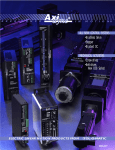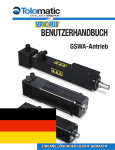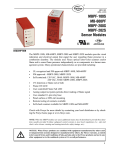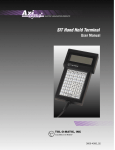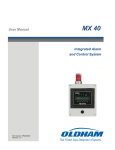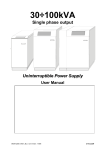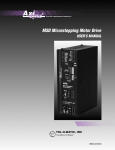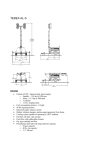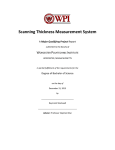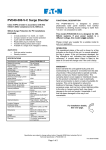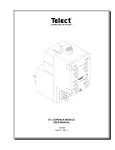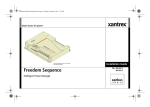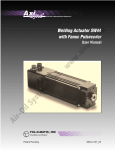Download DMCLDC Closed Loop DC Drive User Guide
Transcript
ELECTRIC LINEAR MOTION PRODUCTS DMCLDC Closed Loop DC Drive USER'S MANUAL TOL-O-MATIC, INC Excellence in Motion® 3600-4078 © Copyright 1997 Tol-O-Matic, Incorporated. All rights reserved. Axidyne and Tol-O-Matic are registered trademarks of Tol-O-Matic Incorporated. All other products or brand names are trademarks of their respective holders. Contents Introduction About this Manual ..................................................................................... 1 Safety Symbols........................................................................................1 CW, CCW Definition ..............................................................................1 System Descriptions Overview ......................................................................................................3 Closed Loop Dc Drive System ....................................................................4 Closed Loop Dc Drive Module ...................................................................5 Features........................................................................................................6 Connectors, Indicators and Potentiometers Overview ......................................................................................................7 Ac Power Input ............................................................................................7 Controller Interface Board..........................................................................8 Motor Drive Board ......................................................................................9 Fault Indicators ...........................................................................................9 Position Error LED...............................................................................10 Overcurrent Trip LED ..........................................................................11 Potentiometers ..........................................................................................12 Gain ..................................................................................................12 Damping ..............................................................................................12 Overcurrent Trip ..................................................................................13 System Wiring Safety Considerations ...............................................................................15 Grounding..................................................................................................15 Wiring Ac Power ........................................................................................15 Encoder/Motor Connection.....................................................................17 Encoder.................................................................................................17 Motor ..................................................................................................18 Wiring to the Controller Interface............................................................18 Control Wiring to the Motor Drive Board................................................20 Reset ..................................................................................................20 Fault Relay ...........................................................................................20 Adjustments Setting the Potentiometers.......................................................................21 Gain Potentiometer .............................................................................21 Damping Potentiometer......................................................................21 Overcurrent Trip Potentiometer..........................................................21 i C O N T E N T S Technical Specifications DMCLDC Drive Moduler Specifications .................................................22 Dimensions................................................................................................24 Mounting Information DMCLDC Mounting..................................................................................25 Location .....................................................................................................25 Recommended Motors Overview ....................................................................................................26 Features......................................................................................................27 Motor Mounting ........................................................................................27 Motor Specifications .................................................................................28 MRB-231...............................................................................................28 MRB-341...............................................................................................29 MRB-342...............................................................................................29 MRB-401...............................................................................................30 MRB-402...............................................................................................30 Encoder ......................................................................................................31 Overview...............................................................................................31 Features ................................................................................................31 Dimensions ..........................................................................................31 ii Introduction About This Manual The Axidyne Closed Loop Dc Drive System is designed to provide cost effective solutions for linear motion profiling and positioning, where a separate source of step and direction input is available. The Tol-O-Matic SSC controllers are appropriate as are stepper controllers within a host PLC. This manual provides information necessary to configure, install and operate these Axidyne system components in the selected application. If you have difficulty configuring or installing your system, please contact your local distributor for help, or call Tol-O-Matic at 1-800-328-2174. SAFETY SYMBOLS The following symbols are used throughout this manual to alert the user to potential safety hazards. Caution! When this symbol appears, exercise care to avoid the possibility of sustaining slight operator injury or equipment damage. N WARNING! When this symbol appears, exercise extreme caution to avoid an IMMEDIATE DANGER of sustaining severe operator injury or irreparable equipment damage. NOTE: Failure to comply with cautions and requirements in this manual, may result in damage to equipment not covered under Tol-O-Matic warranties. CW, CCW DEFINITION For all references in this manual, clockwise or counterclockwise rotation of the motor shaft is as viewed when looking at the motor mounting face. If the motor is direct-coupled to a right-hand screw actuator, CCW rotation will move the carrier toward the motor. 1 2 System Description Overview Typical electronic linear motion control systems consist of the following elements: Motor: Provides the torque and speed necessary for an actuator to meet application requirements. Drive: Converts the signal received from the controller or PLC to actually move the motor. In addition, the drive must convert the local power source (typically 115 Vac, 60 Hz) to the power input required by the motor. The power ratings (watts) of the motor and the drive must match the peak and RMS requirements of the application. Controller: Features I/O connections to receive inputs from a programmable logic controller (PLC) or other operator interface and convert them to output signals to the drive module to properly control the motor and to achieve the required motion profile(s) Operator Interface: An optional device used by the system operator to program tr signal the controller remotely. The performance of an electric linear actuator system is determined by the type of control system used with the actuator (i.e. dc openloop brush servo, stepper, or ac brushless servo). In general, dc systems represent a low-cost, mature technology easily applied to meet basic linear motion needs. 3 S Y S T E M D E S C R I P T I O N Closed Loop Dc Drive System The closed-loop dc drive system comprises a closed-loop dc drive module (DMCLDC) and a dc brush servo motor. The system requires step and direction signal inputs from a controller to operate as a positioning drive. The motor embodies an encoder which provides speed and position feedback to the drive module, to implement proportional and derivative closed loop control, in a position controlling mode. Tol-O-Matic offers a range of dc brush servo motors with torque speed characteristics to match the Axidyne family of actuators. D.C. MOTOR ENCODER OPEN-CHASSIS Dc DRIVE MODULE OPTIONAL OPERA OPERATOR TOR INTERFACES INTERF ACES open-chassis closed loop drive PLC (via I/O PRC-222 cable) Axidyne Power Supply (48 vdc ) NOTE: EUROPEAN SUPPLY VOLTAGE INPUT AVAILABLE BY REQUEST AS A MODIFICATION. 115 VAC/60 HZ.* fig.1 4 "stepper Controller" S Y S T E M D E S C R I P T I O N Closed Loop Dc Drive Module Available in an open-chassis configuration, the closed loop dc drive module consists of a closed loop dc drive and a 48 Vdc power supply. It is designed for single- or multi-axis applications with a positioning controller being supplied remotely. It has inputs for a pulse train and direction signal to be provided by an external stepper controller or PLC. Tol-O-Matic's closed loop drive utilizes a P.D. (proportional and derivative) feedback loop for closing the loop around the motor. The Closed Loop Dc Drive module has three main functions: 1) convert 115V/60 Hz. supply power to the voltage and current level the motor requires to produce the desired speed and torque; 2) respond appropriately to the controllers pulse train and an encoder feedback input to ensure that the desired motor profile position is achieved; and 3) provide position holding torque. Using the latest pulse-width-modulation (PWM) drive technology, Axidyne closed loop dc drives provide smooth, quiet motor operation at low speed, prolonged motor brush life, reduced heat build-up and reliable repetitive solid-state reversing. Dc Drive Module Configuration Dc Drive Power Supply fig.2 5 S Y S T E M D E S C R I P T I O N Features • 10 Amp continuous, 15 Amp peak power supply rating. • Position feedback accomplished via a two channel (A & B) differential incremental encoder. • Proportional + Derivative (PD) feedback loop for closing the loop around the motor. • Final position error of +/- 2 encoder counts, with repeatability typically +/- 1 encoder count. • Position error (+/- 127 encoder counts) and current trip faults. • Current trip point potentiometer for setting torque fault limit. • Fault status via a solid state Form "C" output (Current trip or Position error). • No motor holding torque while in a fault condition. • Fault condition indication via 2 L.E.D's to indicate current trip and position error faults for field diagnostics. • Opto-isolated external I/O power (Vdc I/O). • Potentiometer for Damping and Gain adjustment. • Opto-isolated inputs (pulse,and, reset, and quad/full). • Dedicated reset input for clearing fault condition. • Dedicated pulse and direction inputs for remote stepper type controller interface. • Five catalog dc brush servo motors in three frame sizes with encoders. 6 Connections, Indicators and Potentiometers Overview This section is intended to provide a comprehensive description of the DMCLDC Drive Module inputs, outputs, indicators, connectors and adjustments. Details on system wiring and adjustments follow. Ac Power Input 115 Vac/Neutral/GND: Terminals for ac power (see Installation for wiring diagrams) are mounted adjacent to the transformer on the main chassis plate Power Input fig. 3 7 C O N N E C T O R S , I N D I C A T O R S P O T E N T I O M E T E R S A N D Controller Interface Board The controller interface board provides opto-isolation for step and direction inputs from the controller. It also provides the regulated 5V Vdc for use by the Motor Drive Board. The stepper controller source must provide a non-inverting pulse input, either sinking or sourcing. User collections required are pulse and direction signals with a 5-30 Vdc I/O source. fig. 4 8 C O N N E C T O R S , I N D I C A T O R S A N D P O T E N T I O M E T E R S Motor Drive Board The motor drive board regulates the voltage of the dc power buss to that required for the motor speed and load. There are three connectors for user hook-up. See system wiring for details BLACK RED 1 2 3 4 J3 1 Q2 F1 D8 CB G Q3 C11 U6 S Q5 R3B C18 G D S Q6 U2 C32 C21 R60 C33 C34 U12 R45 R44 C9 R57 U4 U15 C17 C38 C10 C27 U10 C40 R67 J5 Y1 TOL-O-MATIC ENCODER P/N 36009070 C24 R66 C E Q1 Q8 B C22 U3 R23 D1 U13 C16 R26 R25 R21 R54 C26 J4 D5 C B D6 C25 U8 C7 R37 D S 6 R59 C23 D G R43 C31 C39 C37 C36 C35 S D7 D9 R48 R53 R49 R52 R39 D10 D G Q4 C20 C12 D11 Q7 D2 R61 R63 R64 R65 BLUE BLACK R46 R34 R41 D S R51 C29 C6 C30 R62 R16 R24 R29 R30 R31 R15 GREEN G U1 C15 C5 C4 C13 R53 R49 R52 R39 R6 C2 1 2 3 4 5 YELLOW 1 1 R13 R5 R11 9 10 11 12 WHITE R40 R50 R42 D12 J2 RED R4 RB R7 R3 R9 C14 R1 C3 C28 6 7 8 RESET J1 5-30 Vdc + ve 1 2 3 4 5 GND R47 MOTOR fig. 5 RESET AND FAULT J1 has 12 terminal points. User connections are required for a 530Vdc I/O (J1-4) source used in conjunction with Reset (J1-8) (after fault). Reset requires a normally closed contact to the external Vdc I/O GND. Vdc I/O is usually derived from the controller providing the step and direction inputs. Opening the contact resets the drive. A form C solid-state relay provides N.O. and N.C . contacts for fault indication (J1-10,11,12). 9 C O N N E C T O R S , I N D I C A T O R S P O T E N T I O M E T E R S A N D ENCODER TERMINALS J2 has six terminal points. J2-1 and 6 provide +5V and ground for driving the encoder. J2 2,3,4,5 are connections for the encoder pulses. MOTOR TERMINALS J3 has four terminal points. J3-2 and 3 are motor positive (red motor lead) and negative (black motor lead) terminals, respectively. FAULT INDICATORS LED's to indicate Position Error and Overcurrent Trip are located on the motor drive board at J4 amd J5 respectively. POSITION ERROR LED The position error detector circuit shuts off (faults) the drive if the position error exceeds the preset limit. The PD (Proportional & Derivative) control loop in the closed loop dc drive calculates error by comparing the commanded position of the motor with its actual position (provided via encoder feedback). If that error is greater than 127 encoder counts, then the position error will be active and will fault the drive, and light the LED (J4). 10 C O N N E C T O R S , I N D I C A T O R S A N D P O T E N T I O M E T E R S OVER CURRENT TRIP LED The over current trip circuit protects against overloading of the motor and actuator system while allowing high starting torque for systems with high inertial load. The overcurrent detection circuit monitors motor current build-up above a set value at any time during operation. Refer to Installation for adjustment information. When activated the circuit faults the drive and lights the Current Trip LED, (J5) fig. 6. FAULT N.C. 10 FAULT COM 11 FAULT N.O. 12 J5 CURRENT TRIP L.E.D. J4 R23 POSITION ERROR L.E.D. fig. 6 11 C O N N E C T O R S , I N D I C A T O R S P O T E N T I O M E T E R S A N D Potentiometers GAIN DAMPING CURRENT LIMIT fig.7 There are three adjustment potentiometers on the motor drive board. GAIN Position error adjustment between the commanded and actual position feedback signal. Proportional gain is the response to the current value of the error signal. It is analogous to a spring constant, where the larger the value, the stiffer the spring. The gain potentiometer is 25 turns (CW / CCW increases / decreases the system gain respectively). DAMPING System settling time adjustment between the system's natural and operating frequency. This is generally considered the damping of perturbations in position and velocity. It is analogous to a shock absorber in a automobile. The gain potentiometer is 25 turns (CW / CCW increases / decreases the system damping respectively). 12 C O N N E C T O R S , I N D I C A T O R S A N D P O T E N T I O M E T E R S OVER CURRENT TRIP Used to adjust the maximum current allowed before faulting the drive. This allows protection against overloading of motor and actuator system while allowing high starting torque for systems with high inertial load. The overcurrent detection circuit monitors motor current build-up above a set value at any time during operation.The current trip pot is 25 turns (CW / CCW increases / decreases the current trip level respectively). This pot should be set after the system is tuned and programmed. See page 19 for information about setting these potentiometers. 13 Notes: 14 System Wiring Safety Considerations When installing any motion control system, safety should be a primary concern. All Axidyne hardware should be installed to conform with local and national electrical safety codes. Failure to observe safe working practices when installing or servicing this equipment can expose you to dangerous voltages. Grounding In general, all electrical chassis and enclosures must be connected to earth ground through a grounding electrode conductor to provide a low impedance path for ground fault or noise-induced currents. Wiring AC Power A single-point grounding setup is recommended, and all earth ground connections must be continuous and permanent. Prepare all other components and mounting surfaces prior to installation so that good electrical contact is made between the component enclosure and the mounting surface. Remove the paint from equipment surfaces where the ground contact will be bolted to a panel, and use star washers to ensure solid bare metal contact. To connect the DMCLDC to an ac power supply, consult the wiring diagram . WARNING: All AC power must be disconnected prior to installation of wiring. Failure to observe safe working practices when installing or servicing this equipment can expose you to dangerous voltages. Dc Drive Module Ac wiring Green (ground) White Black (115 Vac/60 Hz) 15 S Y S T E M W I R I N G 1. Connect the BLACK lead to 115 Vac terminal. 2. Connect WHITE wire to NEUTRAL terminal. 3. Connect GREEN wire to ground. NOTE: The 115V source should be fused or breakered at no more than 15 Amps. 16 S Y S T E M W I R I N G Encoder Wires ENCODER BLACK RED 1 2 3 4 J3 1 G Q2 F1 D8 CB G Q3 C11 U6 R46 R34 S G Q5 R3B C18 G D S Q6 U2 C32 C21 Q7 D2 R60 C33 C34 U12 R45 R44 C9 R57 U4 U15 C17 C38 C10 C27 U10 C40 R67 J5 Y1 ENCODER C24 R66 C E Q1 Q8 B C22 U3 R23 D1 U13 C16 R26 R25 R21 R54 C26 J4 TOL-O-MATIC P/N 36009070 D5 C B D6 C25 U8 C7 R37 D S 6 R59 C23 D R43 C31 C39 C37 C36 C35 S G D7 D9 R48 R53 R49 R52 R39 D10 D Q4 C20 C12 D11 R41 D S R51 C29 C6 C30 R62 R16 R24 R29 R30 R31 R61 R63 R64 R65 BLUE BLACK R40 R50 U1 R15 GREEN 1 R5 R11 C2 1 2 3 4 5 YELLOW C3 C15 C5 C4 C13 R53 R49 R52 R39 R6 9 10 11 12 WHITE R4 RB R7 R3 R9 C14 R1 R42 D12 J2 RED 1 R13 C28 6 7 8 RESET J1 5-30 Vdc + ve 1 2 3 4 5 GND R47 MOTOR There are six wires connecting the Encoder to the Drive Module. Terminal connections are +5Vdc to power the encoder, encoder GND, and the other four are connected to the A and B channels, and serve as the encoder feedback to the dc closed loop drive module. Use of shielded cable is strongly recommended with the shield grounded at one end only Wire the Tol-O-Matic encoder to the drive board terminal J2 as follows: Wire Color Code Red Black White Yellow Green Blue Orange Brown Encoder Terminal Terminal Block +5V GND A+ AB+ BI+ I- 1 6 2 3 4 5 (not used) (not used) 17 S Y S T E M W I R I N G MOTOR Connect the red and black motor leads to terminals 2 and 3 ( Motor + and Motor -) respectively, of terminal block J3 on the Motor drive board Wiring to the Control Interface Instructions for connecting the DMCLDC drive to a “generic” stepper controller are provided below and are illustrated . The pulse and direction inputs to the drive are opto-isolated on the Controller Interface Board. 1. The Axidyne DMCLDC drive has a non-inverting pulse input. A non-inverting pulse is a low-going signal that advances the motor one step when a high pulse is encountered. Follow the directions sent with the stepper controller to send a noninverting pulse signal to the drive. The CLDC drive module can take either a sinking or a sourcing pulse indexer. Consult the manual that is shipped with your stepper controller to see which one your controller has. Most stepper controllers have sinking outputs for step and direction. For sinking outputs, use steps 2, 3 and 4 for wiring: 2. Connect the "Step" or "Pulse" output on the controller to the PUL- input on the controller interface. 3. Connect the "Direction" or "CW/CCW" output on the stepper controller to the DIR- input on the controller interface. 4. Jumper the DIR+ and PUL+ inputs on the drive, and connect them to the positive terminal of the 5 to 30 Vdc power supply (Vdc I/O) on the controller. If the controller has sourcing outputs, use steps 2a, 3a, and 4a for wiring: 18 S Y S T E M W I R I N G 2a. Connect the "Step" or "Pulse" output on the controller to the PUL+ input on the drive. 3a. Connect the "Direction" or "CW/CCW" output on the stepper controller to the DIR+ input on the drive. 4a. Jumper the DIR- and PUL- inputs on the drive, and connect them to the negative terminal of the 5 to 30 Vdc power supply (Vdc I/O) on the controller. The remaining terminals on the Controller Interface Board are wired at the factory as follows: Dir Out is the isolated direction signal connected to J1-7 on the motor drive board. Pulse Out is the isolated pulse signal connected to J1-6 on the Motor Drive board. +5V is the 5Vdc supply to J1-1 on the motor drive board. GND is the ground for Vdc and also for the drive power bus, connected to J3-4 (and also J1-3) on the motor drive board. V+ is the positive of the power bus (48Vdc), connected to J3-1 on the motor drive board. 19 S Y S T E M W I R I N G Control Wiring to the Motor Drive Board RESET If the drive faults due to position error or overcurrent, drive current will be shut off with no motor holding torque. To reset this condition it is necessary to open a normally closed connection (that is required to run) between the Reset terminal J1-8 and the ground of the external Vdc I/O (probably on the controller source of the 5-24dc Vdc I/O supply must be connected to J1-4. FAULT RELAY J1 terminals 10,11 and 12 are the connectors to a form C contact of a solid state relay which change state at error or overcurrent faults and can be used to provide remote indication of drive shut down. NOTE: Connection terminals not identified for interconnection on the motor drive board as on the controller interface board are not used. Connection to them may cause damage to the drive module or 20 Adjustments connected apparatus. SETTING POTENTIOMETERS All three are 25 turn pots. The ranges and factory settings of the three potentiometers are: Range Gain 0.35 to 1.75 Volts/Encoder Count Damping 0 to 25 turns Current Trip 2 Amps to 15 Amps Factory Setting Full CCW (0.35 V/Count) 10 turns back from full CW 2 Amps GAIN POTENTIOMETER The 25 turn gain pot can be set at maximum (fully CW) for most conditions. The gain may need to be reduced for heavy load applications. DAMPING POTENTIOMETER The 25 turn damping pot is best at maximum (fully CW), then turned back 5 to 10 turns CCW. This gives the best compromise between good velocity regulation and overly aggressive velocity regulation. Less damping will result in degraded velocity loop performance and may result in instability. More damping may result in instability at low speeds. OVER CURRENT TRIP POTENTIOMETER After the system is tuned and programmed, the current trip should be set. This is done by adjusting the 25 turn current trip pot CCW until the drive current trips while running at maximum load. Then turn the pot 2 to 4 turns CW to allow operating margin. Figure 7. on page 11 shows the potentiometers on the motor drive board. 21 Technical Specifications DMCLDC Drive Module Specifications POWER Input Voltage: 85-132 Vac • Frequency:60 Hz • Current 7 Amp (max) Output Voltage 48 Vdc • Continuous Current: 10 Amp • Peak Current : 15 Amp Note: 1. European Input power available on request as a modification 2. 48 Vdc is no-load output 3. 1 second operating at peak condition PERFORMANCE System Resolution 1000 counts per revolution Position Range Limited by remote step direction controller Velocity Range 50,000 pulses per second 3000 RPM when used With Tol-O-Matic MRB motors and encoders. (requires 1000 step/rev for motor speed as shown) Accel Range Limited by remote step direction controller Over Current Rating 125% of continus rating INPUTS Pulse (step) and Direction Signal Circuit Optically isolated ; 1 K Ohm input impedance; Current 5 mA (min) , 25 mA (max); 25 UDC (max) Direction Input Direction changed on transition Pulse (step) Input Drive steps on positive going transition; Minimum step pulse width 10 microseconds. Reset 22 T E C H N I C A L S P E C I F I C A T I O N S Normally closed momentary contact for resetting faults Encoder Resolution 1000 counts per revolution/500 line encoder POTENTIOMETER INPUTS Current Trip Adjustment of torque limit Gain Position error adjustment between command and actual feedback signals Damping System settling time adjustment between the system natural frequency and operating frequency OUTPUTS Fault Output Form C solid state relay output for position or current trip setting Fault L.E.D Output Diagnostic indication of current trip or position error +5 Vdc L.E.D. Output, indicates power to DMCLDC Drive Module ENVIRONMENTAL Temperature 0-50 degrees C (32-122 degrees F) Humidity 10-95% non-condensing 23 T E C H N I C A L S P E C I F I C A T I O N S Module Dimensions Ø.15 (4) 4.05 1.75 1.01 5.50 TOL-O-MATIC .38 3.63 8.96 9.46 2.50 .25 1.21 4.25 3.6 6.71 24 2.60 Ø4.60 T E C H N I C A L S P E C I F I C A T I O N S DMCLDC Mounting LOCATION The DMLDC module is designed to operate in an industrial environment; however, severe atmospheric contamination, electrical noise, or temperature extremes can affect system performance. To avoid performance problems, operate the DMCLDC system within the following environmental guidelines: Operating Temperature: 0˚-50˚C (32˚122˚F) Humidity: 10-95 percent, non-condensing Leave sufficient room to the side of the module for screwdriver access to the gain, damping and current trip adjustment potentiometers. When mounting system components, care should be taken not to place heat producing devices underneath or near the DMCLDC unit. 25 Recommended Motors Recommended Motors OVERVIEW Axidyne brushed dc motors for use with closed loop drives are brush-type permanent magnet servo motors with encoders. A selection of motor speed/torque characteristics is available to match Axidyne actuator applications. The motors have permanent magnet poles on the stators and apply continuous power to the rotor through the brushes and commutator. fig. 8 These motors are all complete with a 500 count per revolution two channel (A & B) differential incremental encoder for feedback. The encoder is used in the dual (2x) mode, providing resolution of 1,000 counts per revolution . Axidyne Closed Loop Dc Drive systems have a typical final position error of +/– 2 encoder counts. System resolution is a function of screw pitch or belt drive wheel circumference, any drive reduction, ratio and the encoder resolution. 26 R E C O M E N D E D M O T O R S FEATURES • Precision balanced rotors • ABEC class bearings • Ferrite magnetics • Quiet motor designs • Precision machined dimensions • Common NEMA mechanical flanges simplify interfacing to standard gearboxes • Two channel differential encoder (500 count, used in dual (2x) mode). Motor Mounting Axidyne brush dc motors have Nema faces for in-line applications mounting kits are used to attach Axidyne motors to Axidyne screwdrive actuators. The kits include standard mounting plate, spacer and fasteners. NOTE: A flexible coupler between the motor shaft and the load is recommended to isolate the motor from vibration and to compensate for possible slight shaft misalignment. Reverse parallel motor mounting is also available on screw actuators, using an enclosed toothed belt drive with 1:1 or 2:1 ratio. Motors may be direct coupled to belt-drive actuators or drive through a 3:1 reduction box. (See Axidyne product catalog no. 3600-4077 for details). 27 R E C O M E N D E D M O T O R S Model MRB-231 Speed-Torque Characteristics KE: KT: Ra: Rotor Inertia: Max. Temp.: Weight: 4000 SPEED (r.p.m.) 3500 3000 2500 2000 12.7 Volts/1000 r.p.m. 17.1 oz.-in./Amp. 1.7 Ohms 1.92 oz.in.2 105° F. 3.5 lbs. 1500 1000 500 0 0 50 100 150 200 TORQUE (oz.-in.) 20% Duty 100% Duty Speed/Torque 48 Volts Dimensions Ø 1.500/1.498" (38.1/38.0) Ø .195 THRU (4) EQ. SPD. AS SHOWN ON A Ø 2.625 B.C. ROTATION + RED Ø 2.25" (57.2) 5.51 ±.06" (140.0) ENCODER WITH INDEX AND LINE DRIVERS Ø 0.2500/.2495" (6.3/6.3) 2.25" (Sq) (57.2) 2.91"(Max) (73.9) Ø 1.500/1.498" (38.1/38.0) 28 0.81" (20.6) ±.03 0.10" (2.5) FLAT .015 (.38) DP X .63 (16.0) ENCODER CABLE 18" (457.2) LONG CONNECTOR - AMP 103650-7 OR EQ 0.82" (20.8) 1.53" (38.9) R E C O M E N D E D Model MRB-341 Model MRB-342 Speed-Torque Characteristics Speed-Torque Characteristics 4000 3500 4000 3500 3000 SPEED (r.p.m.) SPEED (r.p.m.) M O T O R S 2500 2000 1500 1000 500 3000 2500 2000 1500 1000 500 0 0 0 50 150 100 200 0 100 TORQUE (oz.-in.) 300 TORQUE (oz.-in.) 20% Duty Speed/Torque 48 Volts KE: KT: Ra: Rotor Inertia: Max. Temp.: Weight: 200 20% Duty 100% Duty Speed/Torque 48 Volts 100% Duty 15.12 Volts/1000 r.p.m. 19.75 oz.-in./Amp. 0.97 Ohms 15.36 oz.in.2 105° F. 6.0 lbs. KE: KT: Ra: Rotor Inertia: Max. Temp.: Weight: 15.83 Volts/1000 r.p.m. 20.35 oz.-in./Amp. 0.51 Ohms 20.48 oz.in.2 105° F. 8.4 lbs. Dimensions MRB 341/342 MOTOR Leadwires 24" (610mm) From Frame AMP Connector P/N 103650-7 or EQ MRB341 / 5.80" (147.3) MRB342 / 7.00" (177.8) 18" ±1" (460) Ø 1.53" (138.9) 0.82" ±.03 (20.8) 3.26" Sq. (82.8) 1.25" ±.03 (31.8) 0.10" (2.5) 1.00" (25.4) 0.42" (10.7) 2.74" Sq. (69.6) 1.37" (34.8) Ø.218 [4] Holes (5.5) Ø.500 (12.7) Ø 2.875" (73.0) 29 R E C O M E N D E D M O T O R S Model MRB-401 Model MRB-402 Speed-Torque Characteristics Speed-Torque Characteristics 2000 SPEED (r.p.m.) SPEED (r.p.m.) 4000 3500 3000 2500 2000 1500 1000 500 1750 1500 1250 1000 750 500 250 0 0 0 100 300 200 0 400 TORQUE (oz.-in.) Speed/Torque 48 Volts KE: KT: Ra: Rotor Inertia: Max. Temp.: Weight: 20% Duty 100% Duty 200 400 600 TORQUE (oz.-in.) Speed/Torque 48 Volts 22.5 Volts/1000 r.p.m. 30.5 oz.-in./Amp. 0.6 Ohms 100.67 oz.in.2 105° F. 17 lbs. KE: KT: Ra: Rotor Inertia: Max. Temp.: Weight: 35.8 Volts/1000 r.p.m. 48.4 oz.-in./Amp. 0.87 Ohms 122.28 oz.in.2 105° F. 20 lbs. Dimensions 45¡ 1.90" ±0.3 (47.5) Encoder Wire Harness [MRBN Models Only] Motor Wire 16 Ga Red & Black 0.615" 24" (610) Long Typical (15.6) 1/2 NPT Lead Exit 0.512/.502" (13.00/12.75) Ø 4.00 ±.01" (101.6) Ø 2.498/2.495" (63.45/63.37) 30 Ø.625 / .623" (15.88 / 15.82) 1/4"-20 UNC-28 0.10" x 0.50" DP 0.62" 0.187" (4.75) Drill Depth EQ Square Key X Spaced on a Ø 3.250" B.C. [4] 1.00" (25.4) Long 20% Duty 100% Duty MRB 401[402] 10.85" ±.06 (275.6) MRBN 401[402] 10.19" ±.06 (258.8) 800 Encoders Encoder Overview This is a revolutionary modular type encoder using SMT technology to provide high reliability. Sensors are set up differentially under a single LED light source. Installation is simple using a slide/lock mechanism to align center and gap for maximum performance. No adjustments are required and no mechanical rubbing occurs once installed. The cover has an integral positive locking system which eliminates the usually required mounting hardware. NOTE: To extend the encoder leads use a grounded metal junction box. Ensure continuity of the shield which should be single point grounded. Features • Self aligning • Self centering • Self gapping • Frequency response to 100 KHz (all channels) • Differential Index • Positive lock-on cover Dimensions .64 .82 MAX ENCODER TOP SLIDE LOCK MECHANISM 18" ± 1 1.53 MOTOR INSTALLED COVER 2-56 CLEARANCE HOLE 4-40 CLEARANCE HOLE 31 Notes: 32 TOL-O-MATIC, INC. 3800 County Road 116 Hamel, MN 55340 612.478.8000 Telephone 612.478.8080 Fax http://www.tolomatic.com





































